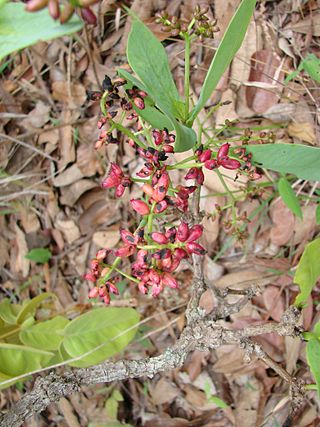
The Francoaceae are a small family of flowering plants in the order Geraniales, including the genera Francoa, commonly known as bridal wreaths. The Francoaceae are recognized as a family under various classification schemes. Under the 2009 APG III system the Francoaceae were included within the Melianthaceae. In the 2016 APG IV system the Francoaceae are again recognized as a family, with Melianthaceae included in the circumscription of Francoaceae.

Acaena is a genus of about 60 species of mainly evergreen, creeping herbaceous perennial plants and subshrubs in the family Rosaceae, native mainly to the Southern Hemisphere, notably New Zealand, Australia and South America, but with a few species extending into the Northern Hemisphere, north to Hawaii and California.

Hipólito Ruiz López, or Hipólito Ruiz, was a Spanish botanist known for researching the floras of Peru and Chile during an expedition under Carlos III from 1777 to 1788. During the reign of Carlos III, three major botanical expeditions were sent to the New World; Ruiz and José Antonio Pavón Jiménez were the botanists for the first of these expeditions, to Peru and Chile.

Bowlesia is a genus of flowering plant in the family Apiaceae. It includes 16 species native to the subtropical Americas, ranging from Oregon to Florida and southeastern Mexico in North America, and from Ecuador and southeastern Brazil to southern Argentina and southern Chile in South America.

Kageneckia is a genus of flowering plant in family Rosaceae.

Neea is a genus of plants in family Nyctaginaceae from the Caribbean region, Central and South America. Members of the genus are commonly called Nia, Neea, or saltwood.

Tournefortia, often called soldierbushes, is a genus of flowering plants in the borage family, Boraginaceae.

Spermacoce or false buttonweed is a genus of flowering plants in the family Rubiaceae. It comprises about 275 species found throughout the tropics and subtropics. Its highest diversity is found in the Americas, followed by Africa, Australia and Asia. It can be used for the treatment of eczema by rubbing the leaves on the affected part.

Chaetanthera is a genus of South American flowering plants in the family Asteraceae native to Argentina, Bolivia, Chile, and Peru.

Tillandsia virescens is a species of flowering plant in the family Bromeliaceae. This species is native to Argentina, Bolivia, Chile and Peru. It was first described in 1802.

Tillandsia purpurea is a species of flowering plant in the family Bromeliaceae. It is endemic to Peru, first described by Ruiz and Pavón in 1802.

Pineda is a genus of flowering plants in the family Salicaceae. It contains two species of shrubs: Pineda incana, which is native to the Andes of Ecuador and Peru, and Pineda ovata, which is native to the Andes of Bolivia.

Acaena pinnatifida is a species of flowering plant in the family Rosaceae. It is known by the common names Argentinian biddy-biddy and California sheepbur. It grows in California, Argentina and Chile. The population from California is sometimes considered to be a distinct species or variety from the population in South America.

Clarisia is a genus of trees in the family Moraceae, native to North and South America, ranging from Mexico to Bolivia.
Riqueuria is a monotypic genus of flowering plants belonging to the family Rubiaceae. It only contains one known species, Riqueuria aveniaRuiz & Pav.

Chondrodendron is a genus of flowering plants belonging to the family Menispermaceae.

Rhynchotheca is a genus of flowering plants belonging to the family Geraniaceae. Its native range is Ecuador to Peru.

Urceolina urceolata is a perennial plant species in the family Amaryllidaceae. The species is native to Peru.

















